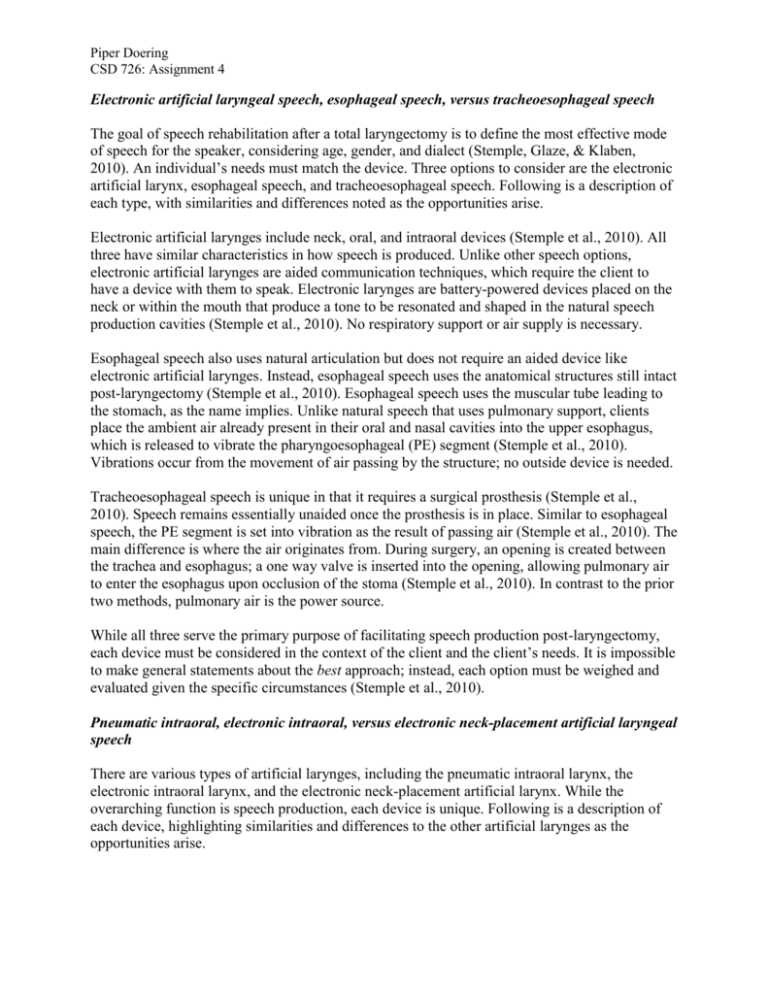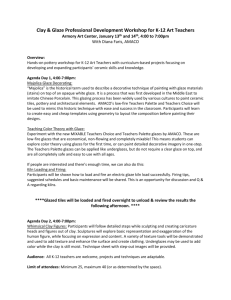Laryngectomy
advertisement

Piper Doering CSD 726: Assignment 4 Electronic artificial laryngeal speech, esophageal speech, versus tracheoesophageal speech The goal of speech rehabilitation after a total laryngectomy is to define the most effective mode of speech for the speaker, considering age, gender, and dialect (Stemple, Glaze, & Klaben, 2010). An individual’s needs must match the device. Three options to consider are the electronic artificial larynx, esophageal speech, and tracheoesophageal speech. Following is a description of each type, with similarities and differences noted as the opportunities arise. Electronic artificial larynges include neck, oral, and intraoral devices (Stemple et al., 2010). All three have similar characteristics in how speech is produced. Unlike other speech options, electronic artificial larynges are aided communication techniques, which require the client to have a device with them to speak. Electronic larynges are battery-powered devices placed on the neck or within the mouth that produce a tone to be resonated and shaped in the natural speech production cavities (Stemple et al., 2010). No respiratory support or air supply is necessary. Esophageal speech also uses natural articulation but does not require an aided device like electronic artificial larynges. Instead, esophageal speech uses the anatomical structures still intact post-laryngectomy (Stemple et al., 2010). Esophageal speech uses the muscular tube leading to the stomach, as the name implies. Unlike natural speech that uses pulmonary support, clients place the ambient air already present in their oral and nasal cavities into the upper esophagus, which is released to vibrate the pharyngoesophageal (PE) segment (Stemple et al., 2010). Vibrations occur from the movement of air passing by the structure; no outside device is needed. Tracheoesophageal speech is unique in that it requires a surgical prosthesis (Stemple et al., 2010). Speech remains essentially unaided once the prosthesis is in place. Similar to esophageal speech, the PE segment is set into vibration as the result of passing air (Stemple et al., 2010). The main difference is where the air originates from. During surgery, an opening is created between the trachea and esophagus; a one way valve is inserted into the opening, allowing pulmonary air to enter the esophagus upon occlusion of the stoma (Stemple et al., 2010). In contrast to the prior two methods, pulmonary air is the power source. While all three serve the primary purpose of facilitating speech production post-laryngectomy, each device must be considered in the context of the client and the client’s needs. It is impossible to make general statements about the best approach; instead, each option must be weighed and evaluated given the specific circumstances (Stemple et al., 2010). Pneumatic intraoral, electronic intraoral, versus electronic neck-placement artificial laryngeal speech There are various types of artificial larynges, including the pneumatic intraoral larynx, the electronic intraoral larynx, and the electronic neck-placement artificial larynx. While the overarching function is speech production, each device is unique. Following is a description of each device, highlighting similarities and differences to the other artificial larynges as the opportunities arise. Pneumatic intraoral speech utilizes pulmonary air as the primary power source (Stemple et al., 2010). This device is partially within the client’s mouth. A cuff containing a vibrating membrane is placed over the stoma by hand, and as a client expels air for speech, a plastic tube transmits the vibrations from the membrane to mouth (Stemple et al., 2010). As with any object within the mouth, speech may be distorted if the tube is interfering with natural articulation. Since individuals use natural air production, loudness levels can vary with breathing and no electronic buzzing is present (Stemple et al., 2010). The source for electronic intraoral speech is also within the mouth; however, this unit is mounted within an upper denture (Stemple et al., 2010). This battery-operated unit consists of a speaker and amplifier that produce a natural voice tone (Stemple et al., 2010). Similar to the pneumatic intraoral device, this unit can control the loudness of speech production. Perceptual measures of voice, such as loudness and pitch, are controlled through an outer control unit (Stemple et al., 2010). With the tone being produced in the mouth, clients can directly shape the vibrations through natural articulation. Electronic neck-placement devices require adequate sound transfer through the skin, which is unlikely immediately after a laryngectomy (Stemple et al., 2010). Similar to the previous devices, electronic neck-placement devices shape vibrations through natural articulation. Vibrations begin upon placement of the device onto the neck, as the name implies. This requires finding a placement that is most conducive to voicing, allowing vibrations to transmit through the tissues and into the oropharynx effectively (Stemple et al., 2010). Just as the electronic intraoral devices, loudness and pitch can be controlled through switches on the device (Stemple et al., 2010). As with most electronic devices, a buzzing will be present. All three of the above-mentioned artificial larynges are viable speech production options for clients post-laryngectomy, with similarities and differences present among all three. Each client will have to be considered on an individual basis, so the appropriate device can be chosen. Describe the key components for counseling laryngectomy patients and their families. Counseling is necessary for speech-language pathologists (SLPs) to incorporate into postlaryngectomy therapy, as one might expect when working with clients who have undergone significant life changes. A client’s social circles should also be considered during counseling. While this is a challenging task, knowing the key components to counseling post-laryngectomy can help to focus an SLP’s approach. These main components include emotional support, trust, and education. Life changing events bring with them a wave of emotions: sadness, anger, fear, worry, disbelief. An SLP must recognize these emotions, and listen actively and sensitively to the client (Glaze, 2005). This does not come easy without guidelines, especially during the early stages of recovery. Guidelines to be considered include: honest reactions, staying neutral among family members, staying positive without being a “cheerleader,” and eliciting suggestions from the clients and families throughout the process (Glaze, 2005). The aim is to empower and comfort all who are involved. 2 Trust is a key component to all relationships, and is vital between an SLP and client. Trust is often associated with honesty, which is one characteristic that clients require during feedback about speech intelligibility (Glaze, 2005). A clinician must also facilitate open discussions with the client. In particular, clients benefit from open discussions regarding physical disfigurement, since this adjustment can have profound effects on overall well-being (Glaze, 2005). Postlaryngectomy clients rely on SLPs to make this new world more familiar to them. Thus, clients must trust an SLP’s competency (Glaze, 2005). Competency relates directly to an SLP’s accuracy of information during the education process. Open discussions carry through to education, too. Clients and families must feel that all questions will be considered and respected (Glaze, 2005). In addition, an SLP must be sure that all responses are understood. Clients and families may be unfamiliar with speech rehabilitation terminology, so an SLP should use short, direct language (Glaze, 2005). The education component to counseling may be overwhelming with the abundance of information to be provided. To ease minds, it is best to provide supplemental information for the client and family to review at home (Glaze, 2005). The more comfortable an individual is in any situation, the easier a process will go. For clients who have undergone a laryngectomy, as well as their families, this comfort results from counseling in the areas of emotional support, trust, and education. Effective counseling leads to strength and independence. Works Cited Glaze, L. (2005). Counseling the laryngectomized patient and family: Considerations before, during, and after treatment. In Doyle, P.C. & Keith, R.L. (Eds.), Contemporary considerations in the treatment and rehabilitation of head and neck cancer (pp. 353-378). Austin, TX: ProEd. Stemple, J.C., Glaze, L., & Klaben, B. (2010). Clinical voice pathology: Theory and management (4th ed.). San Diego: Plural Publishing, Inc. – Chapter 9: Rehabilitation of the laryngectomized patient (pp. 327-391). 3






